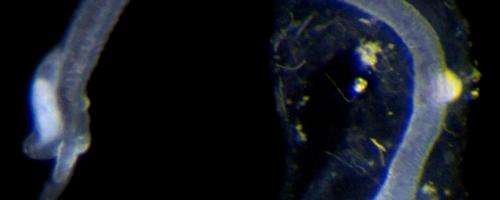The story of a bizarre deep-sea bone worm takes an unexpected twist

The saga of the Osedax "bone-eating" worms began 12 years ago, with the first discovery of these deep-sea creatures that feast on the bones of dead animals. The Osedax story grew even stranger when researchers found that the large female worms contained harems of tiny dwarf males.
In a new study published in the Dec. 11 issue of Current Biology, marine biologist Greg Rouse at Scripps Institution of Oceanography at UC San Diego and his collaborators reported a new twist to the Osedax story, revealing an evolutionary oddity unlike any other in the animal kingdom. Rouse's collaborators included Nerida Wilson (formerly based at Scripps and now at the Western Australian Museum), Katrine Worsaae of the University of Copenhagen, and Robert Vrijenhoek of the Monterey Bay Aquarium Research Institute (MBARI).
Examining bone worms collected at 700 meters (2,296 feet) depth by an MBARI remotely operated vehicle, Rouse observed a surprising new type of Osedax species. Females of the new species are roughly the same size as their previously studied relatives, but males are tens of thousands of times larger than those of other Osedax worms, and are roughly the same size as the females.
"This discovery was very unexpected," said Rouse. "It's the first known example of such a dramatic evolutionary reversal from dwarf males."
"Evolutionary reversals to ancestral states are very rare in the animal kingdom," noted coauthor Vrijenhoek. "This case is exceptional because the genes for producing full-sized adult males should have deteriorated over time due to disuse. But apparently the genes are still there."
Also surprising was the discovery that males of the new species consume bone on their own, something their dwarf relatives don't ever do.
Adding even more peculiarity to the discovery is the mating process for the new species. Previously studied Osedax male dwarfs are permanently attached to their female hosts, and therefore do not need mobility to mate, so the scientists wondered how the newly discovered males are able to seek out a mate, given their independence.
"The evolutionary solution (the new species) found was to actually make the male's body very extendable so he can reach far out to find females to mate with—he can extend his body ten-times its contracted state," said Rouse.
In essence, Rouse said, the entire worm's body has evolved as a tool for mating, "and that's why we named it Osedax 'priapus,' the mythological god of fertility," said Rouse.
The scientists speculate that less competition for space on certain animal bones allowed the evolutionary introduction of Osedax priapus.
"This worm was weird enough as it was and now it's even weirder," said Rouse. "This shows us that there continue to be mysteries in the sea and there is still so much more to discover, especially since we only found these creatures 12 years ago."
Journal information: Current Biology
Provided by University of California - San Diego


















